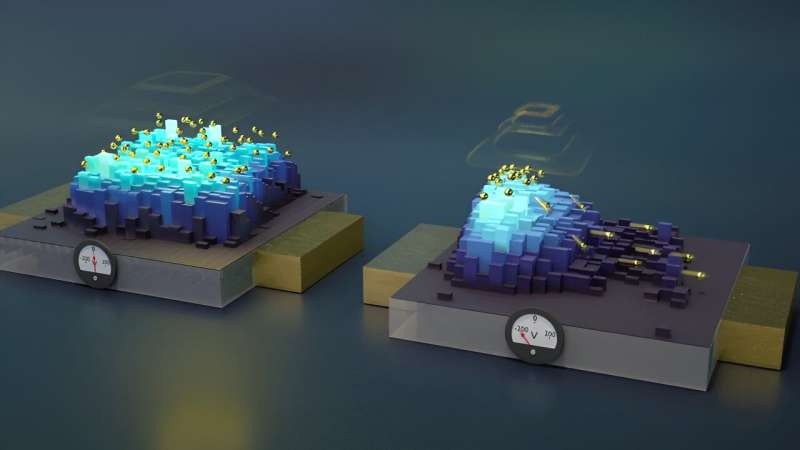The device uses a simple electric diode to manipulate qubits inside a commercial silicon wafer. Credit: Second Bay Studios/Harvard SEAS
The quantum internet would be a lot easier to build if we could use existing telecommunications technologies and infrastructure. Over the past few years, researchers have discovered defects in silicon—a ubiquitous semiconductor material—that could be used to send and store quantum information over widely used telecommunications wavelengths. Could these defects in silicon be the best choice among all the promising candidates to host qubits for quantum communications?
"It's still a Wild West out there," said Evelyn Hu, the Tarr-Coyne Professor of Applied Physics and of Electrical Engineering at the Harvard John A. Paulson School of Engineering and Applied Sciences (SEAS).
"Even though new candidate defects are a promising quantum memory platform, there is often almost nothing known about why certain recipes are used to create them, and how you can rapidly characterize them and their interactions, even in ensembles.
"And ultimately, how can we fine-tune their behavior so they exhibit identical characteristics? If we are ever to make a technology out of this wide world of possibilities, we must have ways to characterize them better, faster and more efficiently."
Now, Hu and a team of researchers have developed a platform to probe, interact with and control these potentially powerful quantum systems. The device uses a simple electric diode, one of the most common components in semiconductor chips, to manipulate qubits inside a commercial silicon wafer.
Using this device, the researchers were able to explore how the defect responds to changes in the electric field, tune its wavelength within the telecommunications band and even turn it on and off.
"One of the most exciting things about having these defects in silicon is that you can use well-understood devices like diodes in this familiar material to understand a whole new quantum system and do something new with it," said Aaron Day, a Ph.D. candidate at SEAS. Day co-led the work with Madison Sutula, a research fellow at Harvard.
While the research team used this approach to characterize defects in silicon, it could be used as a diagnostic and control tool for defects in other material systems.
The research is published in Nature Communications.
Quantum defects, also known as color centers or quantum emitters, are imperfections in otherwise perfect crystal lattices that can trap single electrons. When those electrons are hit with a laser, they emit photons in specific wavelengths.
The defects in silicon that researchers are most interested in for quantum communications are known as G-centers and T-centers. When these defects trap electrons, the electrons emit photons in a wavelength called the O-band, which is widely used in telecommunications.
In this research, the team focused on G-center defects. The first thing they needed to figure out was how to make them. Unlike other types of defects, in which an atom is removed from a crystal lattice, G-center defects are made by adding atoms to the lattice, specifically carbon. But Hu, Day and the rest of the research team found that adding hydrogen atoms is also critical to consistently forming the defect.
More information: Aaron M. Day et al, Electrical manipulation of telecom color centers in silicon, Nature Communications (2024). DOI: 10.1038/s41467-024-48968-w
Journal information: Nature Communications























